Supply Chain Management: Optimizing Manufacturing Network Design
VerifiedAdded on 2023/06/11
|8
|826
|316
Report
AI Summary
This report analyzes the optimization methodology for designing manufacturing networks with reliable promising capabilities, focusing on delivering products within a promised combination of service level and order-to-delivery time. It discusses standardizing network capacities and assessing capacity requirements when formulating product market offers. The methodology involves describing potential locations, product market offers, and estimating inventory and capacity needs. The report also compares initial and optimal network configurations, highlighting differences in plant and center numbers, resources, inventory, and profits. Ultimately, the analysis suggests that while additional inventory may be required for an optimal configuration, the initial network configuration may offer greater profit generation, indicating its feasibility. Desklib provides access to this and other solved assignments for students.

Running head: SUPPLY CHAIN MANAGEMENT
Supply Chain Management
Name of the Student:
Name of the University:
Author’s Note:
Course ID:
Supply Chain Management
Name of the Student:
Name of the University:
Author’s Note:
Course ID:
Paraphrase This Document
Need a fresh take? Get an instant paraphrase of this document with our AI Paraphraser

1SUPPLY CHAIN MANAGEMENT
Table of Contents
Answer to Question 1:.....................................................................................................................2
Answer to Question 2:.....................................................................................................................2
Answer to Question 3:.....................................................................................................................2
Answer to Question 4:.....................................................................................................................4
Answer to Question 5:.....................................................................................................................4
Answer to Question 6:.....................................................................................................................4
Answer to Question 7:.....................................................................................................................5
References:......................................................................................................................................6
Table of Contents
Answer to Question 1:.....................................................................................................................2
Answer to Question 2:.....................................................................................................................2
Answer to Question 3:.....................................................................................................................2
Answer to Question 4:.....................................................................................................................4
Answer to Question 5:.....................................................................................................................4
Answer to Question 6:.....................................................................................................................4
Answer to Question 7:.....................................................................................................................5
References:......................................................................................................................................6
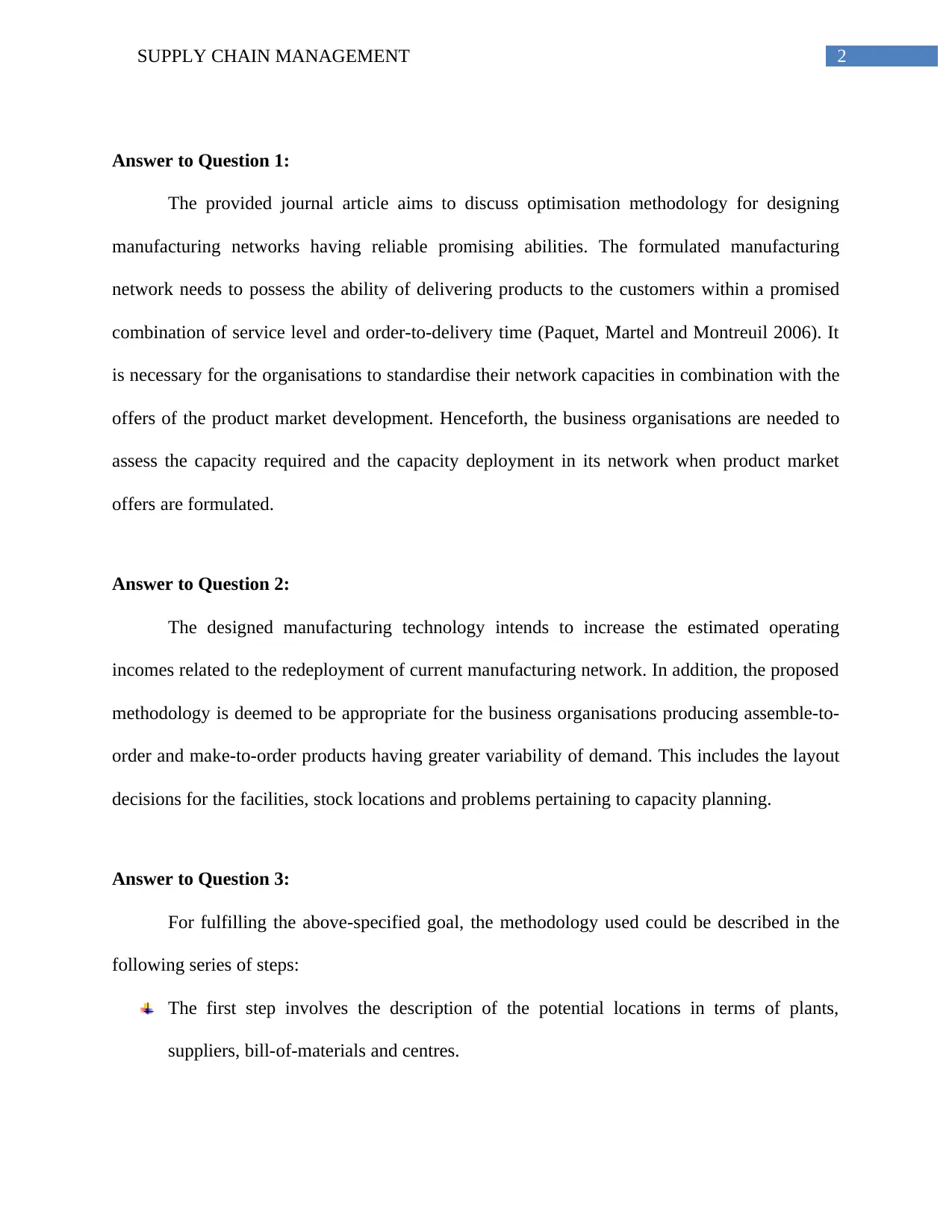
2SUPPLY CHAIN MANAGEMENT
Answer to Question 1:
The provided journal article aims to discuss optimisation methodology for designing
manufacturing networks having reliable promising abilities. The formulated manufacturing
network needs to possess the ability of delivering products to the customers within a promised
combination of service level and order-to-delivery time (Paquet, Martel and Montreuil 2006). It
is necessary for the organisations to standardise their network capacities in combination with the
offers of the product market development. Henceforth, the business organisations are needed to
assess the capacity required and the capacity deployment in its network when product market
offers are formulated.
Answer to Question 2:
The designed manufacturing technology intends to increase the estimated operating
incomes related to the redeployment of current manufacturing network. In addition, the proposed
methodology is deemed to be appropriate for the business organisations producing assemble-to-
order and make-to-order products having greater variability of demand. This includes the layout
decisions for the facilities, stock locations and problems pertaining to capacity planning.
Answer to Question 3:
For fulfilling the above-specified goal, the methodology used could be described in the
following series of steps:
The first step involves the description of the potential locations in terms of plants,
suppliers, bill-of-materials and centres.
Answer to Question 1:
The provided journal article aims to discuss optimisation methodology for designing
manufacturing networks having reliable promising abilities. The formulated manufacturing
network needs to possess the ability of delivering products to the customers within a promised
combination of service level and order-to-delivery time (Paquet, Martel and Montreuil 2006). It
is necessary for the organisations to standardise their network capacities in combination with the
offers of the product market development. Henceforth, the business organisations are needed to
assess the capacity required and the capacity deployment in its network when product market
offers are formulated.
Answer to Question 2:
The designed manufacturing technology intends to increase the estimated operating
incomes related to the redeployment of current manufacturing network. In addition, the proposed
methodology is deemed to be appropriate for the business organisations producing assemble-to-
order and make-to-order products having greater variability of demand. This includes the layout
decisions for the facilities, stock locations and problems pertaining to capacity planning.
Answer to Question 3:
For fulfilling the above-specified goal, the methodology used could be described in the
following series of steps:
The first step involves the description of the potential locations in terms of plants,
suppliers, bill-of-materials and centres.
⊘ This is a preview!⊘
Do you want full access?
Subscribe today to unlock all pages.

Trusted by 1+ million students worldwide
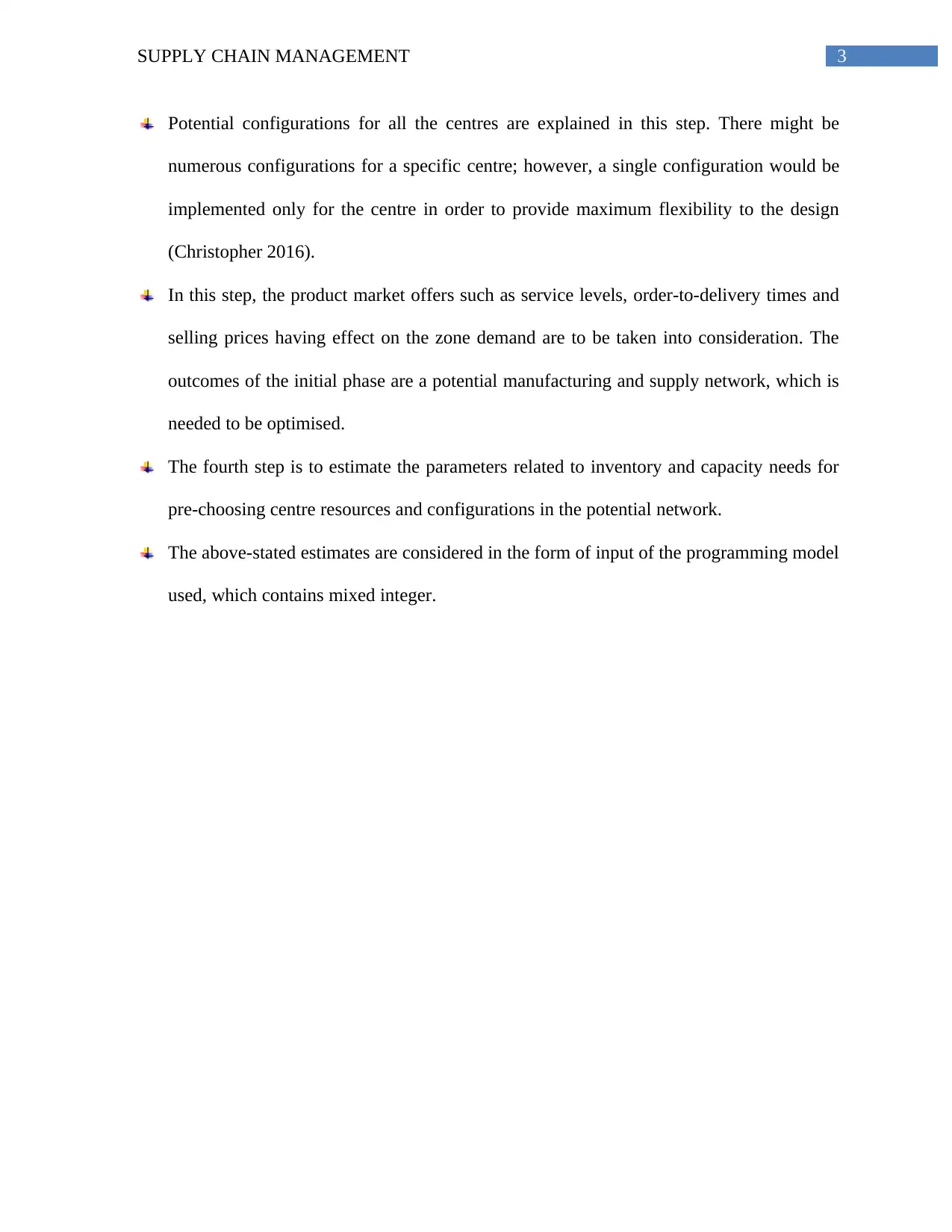
3SUPPLY CHAIN MANAGEMENT
Potential configurations for all the centres are explained in this step. There might be
numerous configurations for a specific centre; however, a single configuration would be
implemented only for the centre in order to provide maximum flexibility to the design
(Christopher 2016).
In this step, the product market offers such as service levels, order-to-delivery times and
selling prices having effect on the zone demand are to be taken into consideration. The
outcomes of the initial phase are a potential manufacturing and supply network, which is
needed to be optimised.
The fourth step is to estimate the parameters related to inventory and capacity needs for
pre-choosing centre resources and configurations in the potential network.
The above-stated estimates are considered in the form of input of the programming model
used, which contains mixed integer.
Potential configurations for all the centres are explained in this step. There might be
numerous configurations for a specific centre; however, a single configuration would be
implemented only for the centre in order to provide maximum flexibility to the design
(Christopher 2016).
In this step, the product market offers such as service levels, order-to-delivery times and
selling prices having effect on the zone demand are to be taken into consideration. The
outcomes of the initial phase are a potential manufacturing and supply network, which is
needed to be optimised.
The fourth step is to estimate the parameters related to inventory and capacity needs for
pre-choosing centre resources and configurations in the potential network.
The above-stated estimates are considered in the form of input of the programming model
used, which contains mixed integer.
Paraphrase This Document
Need a fresh take? Get an instant paraphrase of this document with our AI Paraphraser
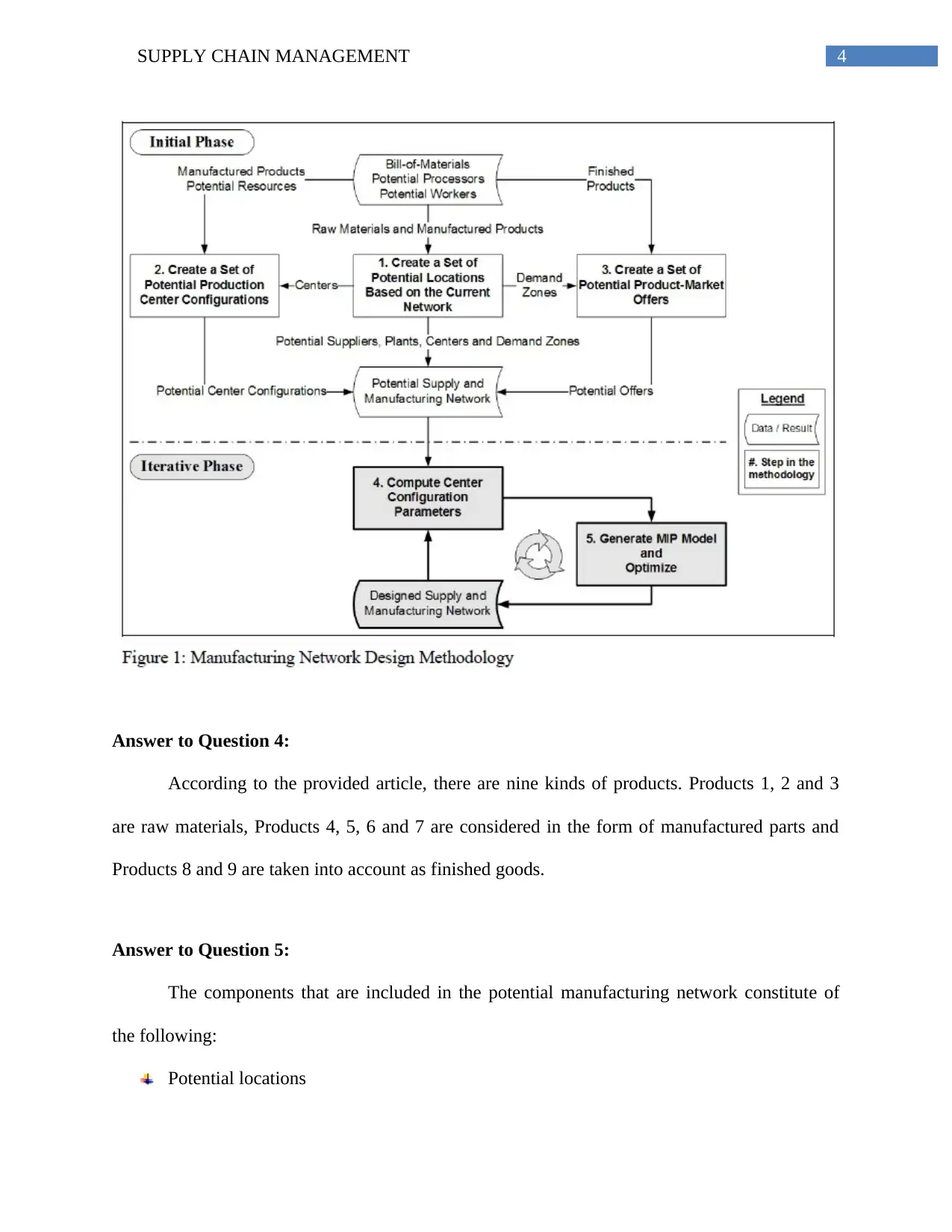
4SUPPLY CHAIN MANAGEMENT
Answer to Question 4:
According to the provided article, there are nine kinds of products. Products 1, 2 and 3
are raw materials, Products 4, 5, 6 and 7 are considered in the form of manufactured parts and
Products 8 and 9 are taken into account as finished goods.
Answer to Question 5:
The components that are included in the potential manufacturing network constitute of
the following:
Potential locations
Answer to Question 4:
According to the provided article, there are nine kinds of products. Products 1, 2 and 3
are raw materials, Products 4, 5, 6 and 7 are considered in the form of manufactured parts and
Products 8 and 9 are taken into account as finished goods.
Answer to Question 5:
The components that are included in the potential manufacturing network constitute of
the following:
Potential locations
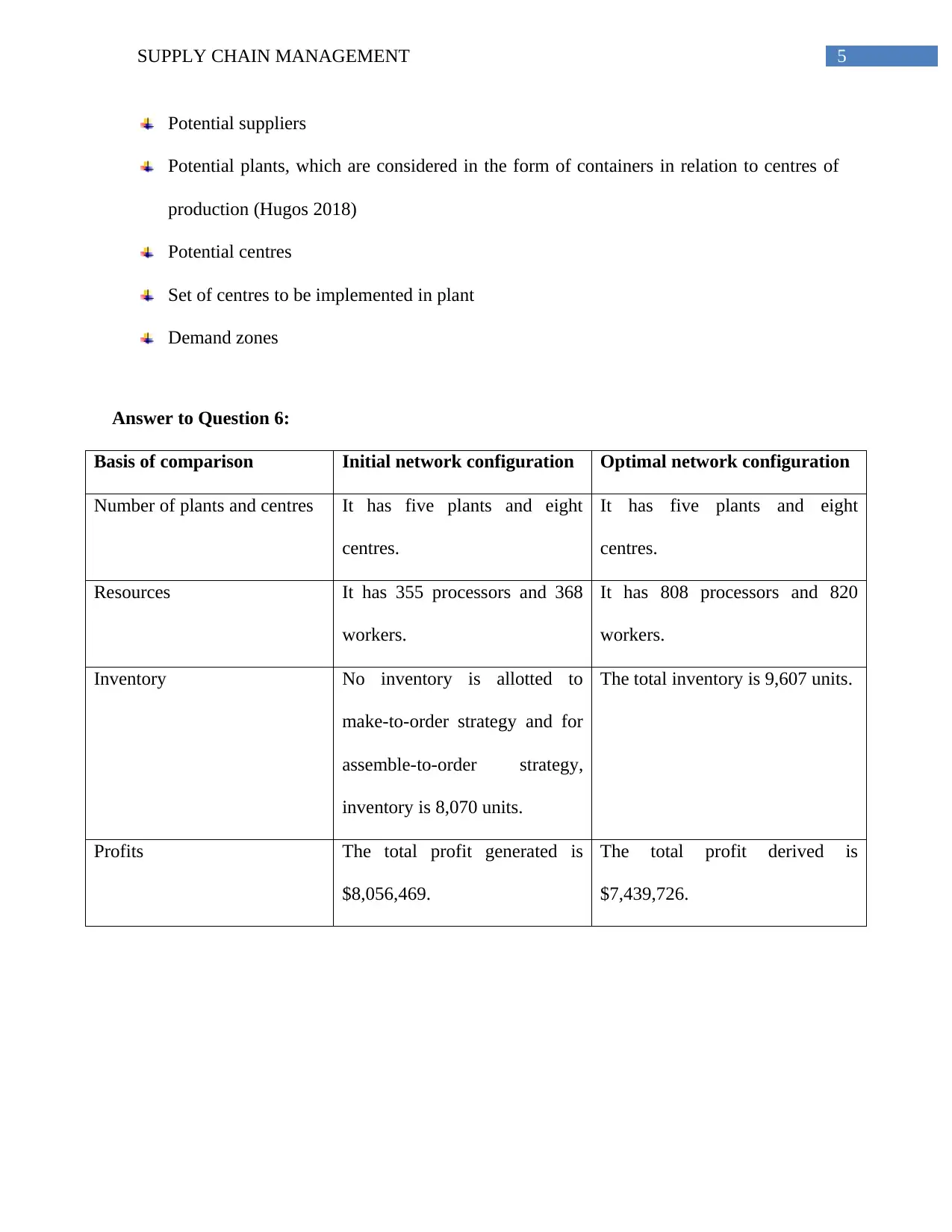
5SUPPLY CHAIN MANAGEMENT
Potential suppliers
Potential plants, which are considered in the form of containers in relation to centres of
production (Hugos 2018)
Potential centres
Set of centres to be implemented in plant
Demand zones
Answer to Question 6:
Basis of comparison Initial network configuration Optimal network configuration
Number of plants and centres It has five plants and eight
centres.
It has five plants and eight
centres.
Resources It has 355 processors and 368
workers.
It has 808 processors and 820
workers.
Inventory No inventory is allotted to
make-to-order strategy and for
assemble-to-order strategy,
inventory is 8,070 units.
The total inventory is 9,607 units.
Profits The total profit generated is
$8,056,469.
The total profit derived is
$7,439,726.
Potential suppliers
Potential plants, which are considered in the form of containers in relation to centres of
production (Hugos 2018)
Potential centres
Set of centres to be implemented in plant
Demand zones
Answer to Question 6:
Basis of comparison Initial network configuration Optimal network configuration
Number of plants and centres It has five plants and eight
centres.
It has five plants and eight
centres.
Resources It has 355 processors and 368
workers.
It has 808 processors and 820
workers.
Inventory No inventory is allotted to
make-to-order strategy and for
assemble-to-order strategy,
inventory is 8,070 units.
The total inventory is 9,607 units.
Profits The total profit generated is
$8,056,469.
The total profit derived is
$7,439,726.
⊘ This is a preview!⊘
Do you want full access?
Subscribe today to unlock all pages.

Trusted by 1+ million students worldwide

6SUPPLY CHAIN MANAGEMENT
Answer to Question 7:
From the above table, it is inherent that additional units of inventory are required for
optimal network configuration. In addition, the profit generated would be more for the initial
network configuration, which denotes its feasibility (Stadtler 2015).
Answer to Question 7:
From the above table, it is inherent that additional units of inventory are required for
optimal network configuration. In addition, the profit generated would be more for the initial
network configuration, which denotes its feasibility (Stadtler 2015).
Paraphrase This Document
Need a fresh take? Get an instant paraphrase of this document with our AI Paraphraser
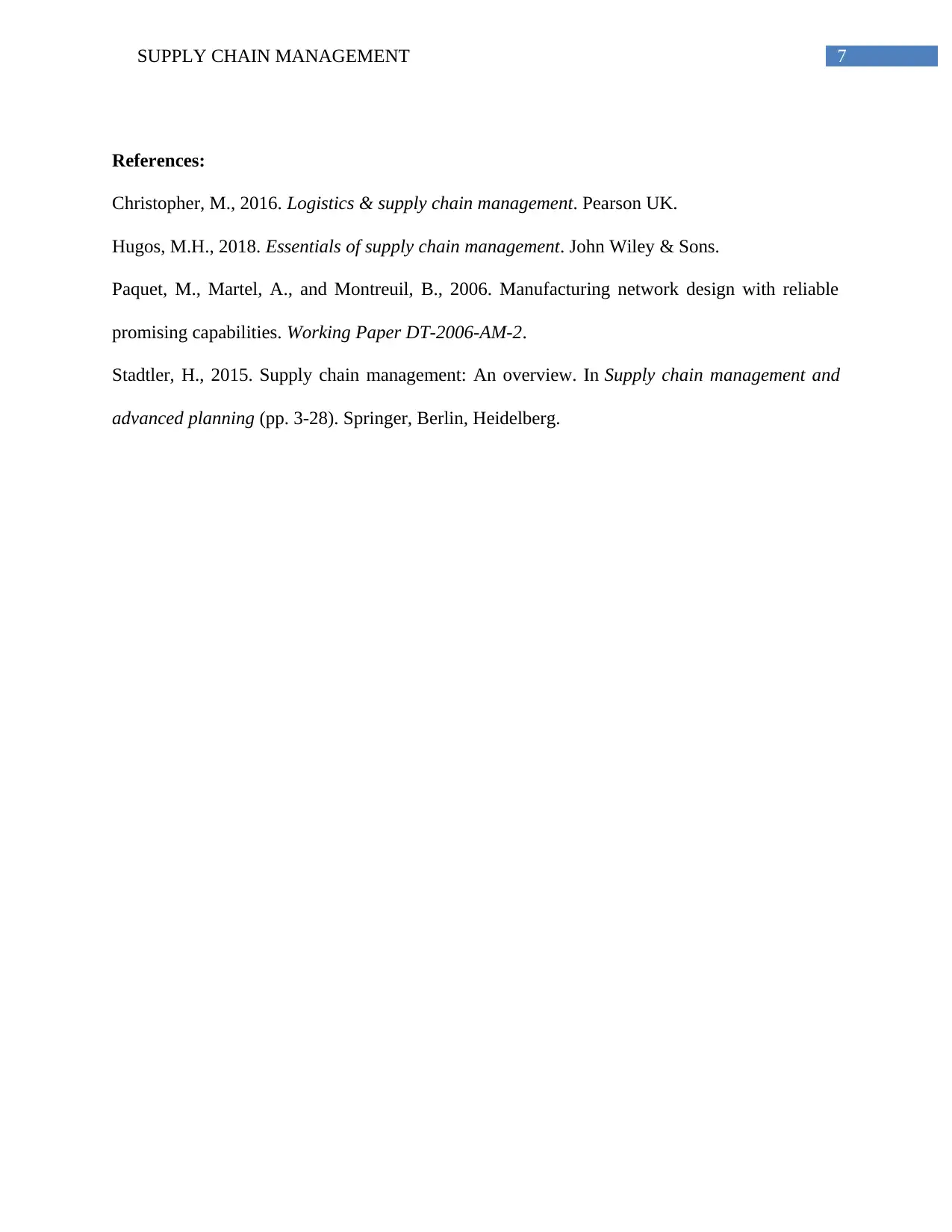
7SUPPLY CHAIN MANAGEMENT
References:
Christopher, M., 2016. Logistics & supply chain management. Pearson UK.
Hugos, M.H., 2018. Essentials of supply chain management. John Wiley & Sons.
Paquet, M., Martel, A., and Montreuil, B., 2006. Manufacturing network design with reliable
promising capabilities. Working Paper DT-2006-AM-2.
Stadtler, H., 2015. Supply chain management: An overview. In Supply chain management and
advanced planning (pp. 3-28). Springer, Berlin, Heidelberg.
References:
Christopher, M., 2016. Logistics & supply chain management. Pearson UK.
Hugos, M.H., 2018. Essentials of supply chain management. John Wiley & Sons.
Paquet, M., Martel, A., and Montreuil, B., 2006. Manufacturing network design with reliable
promising capabilities. Working Paper DT-2006-AM-2.
Stadtler, H., 2015. Supply chain management: An overview. In Supply chain management and
advanced planning (pp. 3-28). Springer, Berlin, Heidelberg.
1 out of 8
Related Documents
Your All-in-One AI-Powered Toolkit for Academic Success.
+13062052269
info@desklib.com
Available 24*7 on WhatsApp / Email
![[object Object]](/_next/static/media/star-bottom.7253800d.svg)
Unlock your academic potential
Copyright © 2020–2025 A2Z Services. All Rights Reserved. Developed and managed by ZUCOL.





